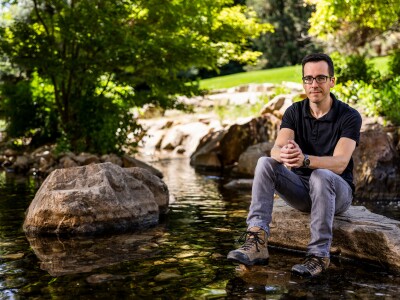Brigham Young University student engineers will return next week to the California Speedway for an international Formula Racing competition with a trimmed-down vehicle that can handle more G-force than performance kings Audi and Porsche.
The team of 12 BYU students has sunk 300 hours of design, production, assembly and testing each week for a year into the bright blue speedster, aiming to beat last year’s rookie score against the 80 universities they will face June 13-16.
“This formula style racer is student-designed, -built and -driven,” said Andrew Enke, a student in mechanical engineering and project manager for the team. “We have been given parameters within the competition, but we have optimized every aspect of it.”
The Formula SAE West competition, coupled with its sister race in Detroit, has become the “World Cup” of undergraduate automotive mechanical engineering, with collegiate motorsports gearing up to be a more competitive field each year. The competition scores teams in eight engineering design categories, including track performance, cost, fuel economy and a business plan presentation that simulates a real-world design and development engineering job.
“The purpose of this competition is to get better prepared engineers when they hit industry,” Enke said. “We aren’t building a car just for speed, but we are looking most importantly at improvements in engineering design. Our car handles G-force better than some high-end sports cars and only costs about $13,000 in production.”
Formula racing is more popular outside the NASCAR-crazed United States, which might explain why a growing numbers of SAE competitive teams are coming from across the globe. At the speedway in Fontana, Calif., BYU will be pitted against mechanical engineers from Brazil, China, South Korea, Mexico and the United Kingdom to see who has designed and built the better racing package.
“This racecar is a senior capstone project that really motivates engineers across disciplines,” said Robert Todd, a BYU professor of mechanical engineering and faculty advisor to the team. “Something that moves always gets engineers excited and this project allows them to see how they are measuring up against their peers—it’s the ultimate teaching tool.”
The project brings together a multidisciplinary team of ten mechanical engineers and two manufacturing students who have worked for two semesters to obtain the right balance of muscle and design.
“The team has done outstanding work, and they have reduced the weight of the vehicle substantially from last year, which has a tremendous effect on the agility of the car,” Todd said.
The BYU team has shaved 100 pounds from last year’s car in an effort to boost performance, as well as upgrading to an ethanol fuel and composite drive shafts using spring steel flex plates, allowing the car to run cleaner and hug corners better along the S-curve track.
“To innovate, we engineered the drivetrain ourselves,” Enke said. “It works like a shoulder joint, flexing and bending the axle to keep the wheels closer to those tight curves while zipping around the course.”
The team has also improved their high-tech data sensors, allowing them to track and test everything going on in their vehicle, from tire temperature and GPS to G-force. Their time spent testing hasn’t come cheap, with tires $110 apiece only good for 90 minutes of fast fun, but the team feels like they have stepped up their technical work to optimize and energize the car and their business plan.
“A lot of the innovations that have come into mainstream cars originated from formula racing,” Enke said. “Anti-lock brakes or paddle-shifters on the steering wheel, like the ones we have, are now becoming standard technology in super cars because of the innovation that came from racing. The engineering we are developing will be in tomorrow’s cars.”
The BYU formula racing team will unveil their competition racing vehicle and its optimized performance and handling Friday, June 8 from 11 a.m. to 12 p.m., in the parking lot north of the Monte L. Bean Life Science Museum.
Writer: Brittany Leonard







